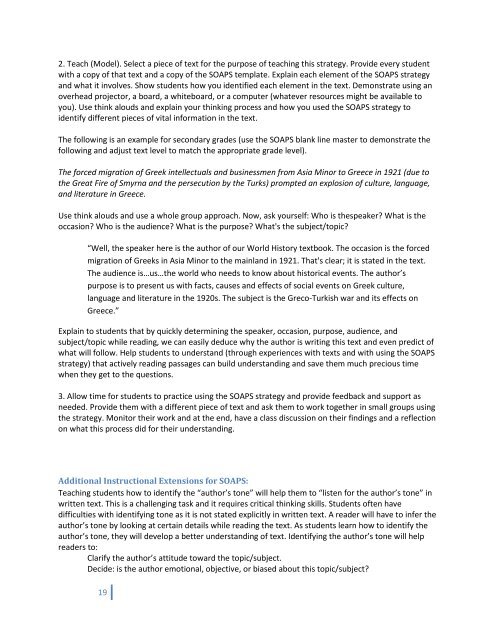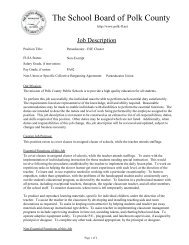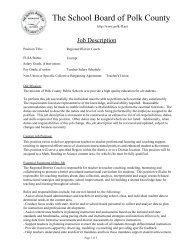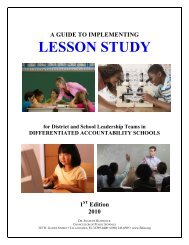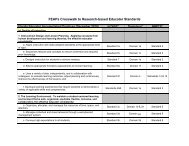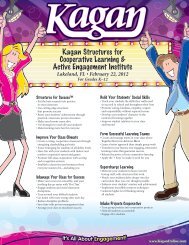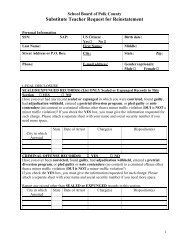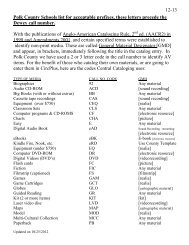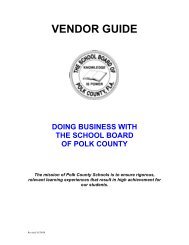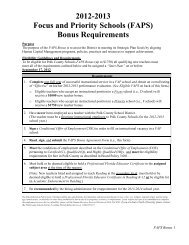Thirty Days to Unlock FCAT Writing Success - Polk County School ...
Thirty Days to Unlock FCAT Writing Success - Polk County School ...
Thirty Days to Unlock FCAT Writing Success - Polk County School ...
Create successful ePaper yourself
Turn your PDF publications into a flip-book with our unique Google optimized e-Paper software.
2. Teach (Model). Select a piece of text for the purpose of teaching this strategy. Provide every student<br />
with a copy of that text and a copy of the SOAPS template. Explain each element of the SOAPS strategy<br />
and what it involves. Show students how you identified each element in the text. Demonstrate using an<br />
overhead projec<strong>to</strong>r, a board, a whiteboard, or a computer (whatever resources might be available <strong>to</strong><br />
you). Use think alouds and explain your thinking process and how you used the SOAPS strategy <strong>to</strong><br />
identify different pieces of vital information in the text.<br />
The following is an example for secondary grades (use the SOAPS blank line master <strong>to</strong> demonstrate the<br />
following and adjust text level <strong>to</strong> match the appropriate grade level).<br />
The forced migration of Greek intellectuals and businessmen from Asia Minor <strong>to</strong> Greece in 1921 (due <strong>to</strong><br />
the Great Fire of Smyrna and the persecution by the Turks) prompted an explosion of culture, language,<br />
and literature in Greece.<br />
Use think alouds and use a whole group approach. Now, ask yourself: Who is thespeaker? What is the<br />
occasion? Who is the audience? What is the purpose? What's the subject/<strong>to</strong>pic?<br />
“Well, the speaker here is the author of our World His<strong>to</strong>ry textbook. The occasion is the forced<br />
migration of Greeks in Asia Minor <strong>to</strong> the mainland in 1921. That's clear; it is stated in the text.<br />
The audience is…us…the world who needs <strong>to</strong> know about his<strong>to</strong>rical events. The author’s<br />
purpose is <strong>to</strong> present us with facts, causes and effects of social events on Greek culture,<br />
language and literature in the 1920s. The subject is the Greco-Turkish war and its effects on<br />
Greece.”<br />
Explain <strong>to</strong> students that by quickly determining the speaker, occasion, purpose, audience, and<br />
subject/<strong>to</strong>pic while reading, we can easily deduce why the author is writing this text and even predict of<br />
what will follow. Help students <strong>to</strong> understand (through experiences with texts and with using the SOAPS<br />
strategy) that actively reading passages can build understanding and save them much precious time<br />
when they get <strong>to</strong> the questions.<br />
3. Allow time for students <strong>to</strong> practice using the SOAPS strategy and provide feedback and support as<br />
needed. Provide them with a different piece of text and ask them <strong>to</strong> work <strong>to</strong>gether in small groups using<br />
the strategy. Moni<strong>to</strong>r their work and at the end, have a class discussion on their findings and a reflection<br />
on what this process did for their understanding.<br />
Additional Instructional Extensions for SOAPS:<br />
Teaching students how <strong>to</strong> identify the “author’s <strong>to</strong>ne” will help them <strong>to</strong> “listen for the author’s <strong>to</strong>ne” in<br />
written text. This is a challenging task and it requires critical thinking skills. Students often have<br />
difficulties with identifying <strong>to</strong>ne as it is not stated explicitly in written text. A reader will have <strong>to</strong> infer the<br />
author’s <strong>to</strong>ne by looking at certain details while reading the text. As students learn how <strong>to</strong> identify the<br />
author’s <strong>to</strong>ne, they will develop a better understanding of text. Identifying the author’s <strong>to</strong>ne will help<br />
readers <strong>to</strong>:<br />
Clarify the author’s attitude <strong>to</strong>ward the <strong>to</strong>pic/subject.<br />
Decide: is the author emotional, objective, or biased about this <strong>to</strong>pic/subject?<br />
19


